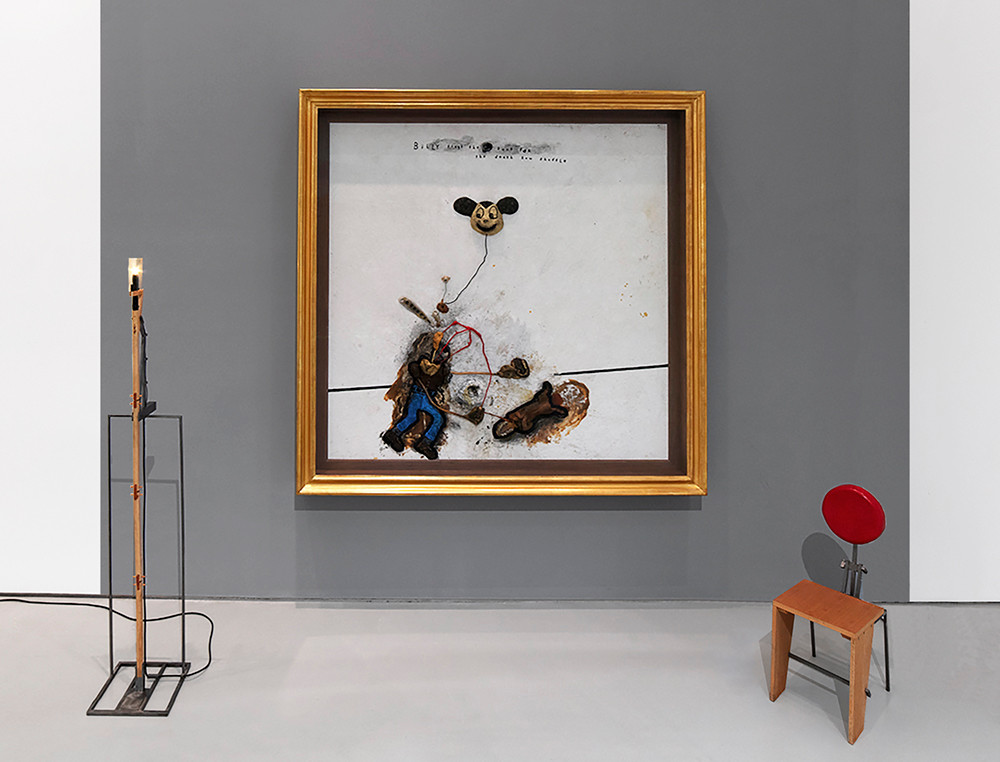[ad_1]
David Lynch’s exhibition at Sperone Westwater, “Squeaky Flies in the Mud,” found the seventy-three-year-old auteur at his worst. Watercolors that might have been made blindfolded, paintings with layers of creepiness caked on like dried shit, themes and moods and motifs beaten into the ground—it was perfectly awful, and I sort of loved it.
In a 2014 write-up for Hyperallergic, Thomas Micchelli asked if anyone would care about Lynch’s fine art career if he weren’t “one of the few truly visionary directors of our time,” but he didn’t get more than a couple paragraphs before admitting that his question’s premise was flawed. It’s surprisingly hard to separate Lynch’s fine art practice from his filmmaking. A student at the Pennsylvania Academy of the Fine Arts from 1965 to 1970, he continued to think of himself primarily as a painter well after cinephiles had begun to revere him as a director. One of his first mature works, a stop-motion spectacle by the name of Six Men Getting Sick (Six Times), 1967, was film, sculpture, and painting all at once. His films are cannily cluttered with tchotchkes and wonky furniture he designed himself—I shudder remembering the little mouth sculpture that hangs over Jeff’s bed in Blue Velvet. Similar pieces found their way into the Sperone Westwater show: a chair that might be a torture device, a lamp that looks like it would bite your hand if you tried to turn it on, etc.
In suggesting that Lynch the director and Lynch the artist are closely linked, I’m not denying that one is better than the other. His new paintings are rarely better than OK, and sometimes quite a lot worse; most often, they just seem like less than the sum of their inspirations. But I, for one, welcome the opportunity to see Lynch’s inspirations laid bare (or barer), and not just because he’s notoriously reluctant to discuss them. This show offered the same guilty pleasure as the recording sessions for Sgt. Pepper’s Lonely Hearts Club Band: something infuriatingly perfect became flawed, mortal, attainable.
It’s tempting to talk about Lynch’s paintings, like his films, strictly in terms of favorite bits and pieces. At Sperone Westwater, there were gaping mouths and flailing little bodies sketched in thick lines, reminiscent of the late Philip Guston. What seemed most distinctly Lynchian about the show, however, was the sense it conveyed of a malevolence that can’t be pinned down to individual details. As the show’s title poetically suggested, Lynch delights in scenes of pain and captivity, the life slowly dripping from his figures. In Billy (and His Friends) Did Find Sally in the Tree (2019), as in so many of the works here, it’s unclear what role the parties have in each other’s agony: if Billy & Co. tortured Sally, she tortured herself, or they’re all merrily torturing one another.
A quote from John Berger’s essay on the figures in Francis Bacon’s and Walt Disney’s work comes to mind: “the marks they bear, their wounds, look self-inflicted. But self-inflicted in a highly special sense. Not by an individual but by the species, Man—because . . . the distinction between individual and species becomes meaningless.” There was a generous slab of Bacon (one of Lynch’s key precursors) in this show, and there was even some Disney—Billy Sings the Tune for the Death Row Shuffle (2018) features a Mickey Mouse doll whose detached head floats queasily away from its body. This image suggests why the pieces in “Squeaky Flies in the Mud” fascinate and disappoint equally. In Lynch’s most arresting creations, something terrible is always hiding behind the dumpsters, some tightly coiled horror putting us back on our heels. In the works shown here—to borrow from Berger again—the worst has already happened. The tension is gone. It’s disturbing enough while you’re in the thick of it, but it fades fast.
[ad_2]
Source link


